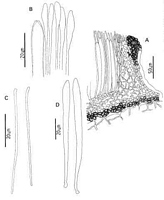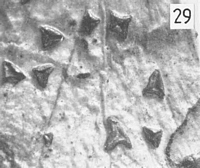|
 Coccomyces phyllocladi Coccomyces phyllocladi
BiostatusPresent in region - Indigenous. Non endemic
Images (click to enlarge)
Caption: Fig. 15 Coccomyces phyllocladi: A, ascocarp margin in cross-section. B, apices of asci and
paraphyses. C, released ascospores. D, asci. | 
Caption: Fig. 29 Macroscopic appearance of ascocarp (x 12).
C. phlyllocladi |
Article: Johnston, P.R. (1986). Rhytismataceae in New Zealand. 1. Some foliicolous species of Coccomyces de Notaris and Propolis (Fries) Corda. New Zealand Journal of Botany 24(1): 89-124 (http://www.rsnz.org/publish/abstracts.php).
Description: Ascocarps developing on both upper and lower phylloclade surfaces, within pale, yellowish
lesions. Lesions often associated with broad, diffuse, brown "host-induced" zone lines (see
notes below). Ascocarps angular in shape, 3-4 sided, 0.6-0.8 mm diam. Immature ascocarps
pale grey, often with yellowish tinge from leaf cuticle, paler along future lines of opening and
adjacent to outer edge of ascocarp, the outside of which is marked by a narrow, black line.
Mature ascocarps black to pale brown with black line at outer edge. No lip cells. Hymenium
bright yellow. Pycnidia absent.
Ascocarps intraepidermal. In vertical section upper stromatal layer up to 18-30 µm wide,
cap of dense, black tissue around opening, otherwise comprising hyaline to brown, thin
walled cells, 4-9 µm diam., paler near the outer edge of the ascocarp. Lower stromatal layer
20-30 µm wide, of 2-4 layers of dark brown, thick walled cells, 4-8 µm diam.
Subhymenium seated on a 45-60 µm wide layer of gelatinised hyphae which also extends up
the sides of the hymenium. Excipulum present, arising from the gelatinous layer at the sides
of the hymenium, elements 2-2.5 µm diam., irregularly branching, septa about 10- 15 µm
apart.
Paraphyses 1.5-2 µm diam., swollen to 4-6.5 µm at the fusoid to clavate apex, extending
15-25 µm beyond asci. Asci 119-137 x 6-7.5 µm, cylindric to subclavate, apex rounded,
wall slightly thickened at apex, with small central pore, non-amyloid, 8-spored. Ascospores
filiform, 62-77 x 1.2-1.5(-2) µm, tapering to basal end, 0-1 septate, more or less straight
when released, surrounded by gelatinous sheath.
CHARACTERISTICS IN CULTURE: Ascospores of PDD 44674 and PDD 44676
germinated on agar plates after 3 days. Growth of colony slow, 0.5-1 cm diam. after 4 weeks,
3 cm diam. after 14 weeks; aerial mycelium cottony, white, sparse; agar brownish in reverse.
Remaining sterile.
Habitat: Found only on fallen phylloclades of Phyllocladus species.
Notes: ETYMOLOGY: phyllocladi; refers to host plant.
NOTES: Many of the infected phylloclades have the appearance of being dissected by
numerous zone lines. These zone lines however are not narrow and black as found in other
species, but are formed by a darkening of the host tissue around the separate fungal lesions,
and are brown, broad, and diffuse at the edges. They appear to be formed by the host as a
reaction to infection, rather than by the fungus.
C. phyllocladi is similar to C. globosus in hymenial dimensions. The two species can be
distinguished by host, absence of pycnidia in C. phyllocladi, and in C. globosus lacking the
gelatinised layer lining the stromatal wall of C. phyllocladi. Cultural characteristics also
differ.
See also notes under C. clavatus.
|